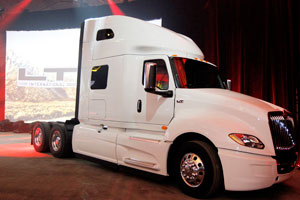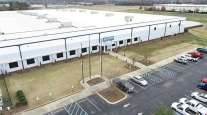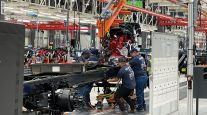Navistar Unveils International LT to Replace ProStar

Lisle, Illinois-based Navistar is using a three-pronged approach to sell the five versions of LT: driver appeal, fuel economy and vehicle connectivity.
Company executives said they already have orders for 2,000 LTs to be built at the Navistar plant in Escobedo, Mexico, starting in November, and the first vehicle will be delivered in December.
“The new International LT Series reflects our vision for the future of the trucking industry, with a host of advancements that support improved driver safety and productivity, as well as fuel efficiency and uptime,” said Bill Kozek, Navistar president for Truck and Parts.
“This new vehicle reflects our strong belief that integrating the best technology will provide customers with a significant operating advantage,” he added.
LT — for linehaul transportation— will replace the 10-year-old ProStar models, which are being phased out in the United States and Canada.
LT’s five body types are a day cab and four sleepers: 56 inches deep, low-roof or high-roof; and 73 inches, high-rise or sky-rise.
LT engines will come with 15 or 13 liters of displacement.
The first engine option for LT is the new Cummins X15 made in Jamestown, New York. This is the replacement for the ISX engine series and it is designed to comply with the federal government’s Jan. 1, 2017, greenhouse-gas emission standards.
In April, Navistar will add its in-house N13 engine as an option.
Also coming that month will be LT’s smaller sibling, the International RH for regional hauling. Jeff Sass, Navistar senior vice president for sales and marketing, said all of the RH trucks will be day cabs and will be aimed at private fleets for distribution work, drayage carriers and petroleum haulers, among others.
LT is the offspring of Navistar’s 2014 concept truck, Project Horizon, that was built to explore fuel economy and advanced technologies. LT also benefitted from the Department of Energy’s SuperTruck research and development program.
Shortly before the LT event, Navistar said it completed its SuperTruck for DOE known as CatalIST.
Company engineering vice presidents Stephen Gilligan and David Majors said several elements from CatalIST are present in LT: the aerodynamic sculpting of the cab, including the slope of the windshield; roof fairings; the dashboard; and lightweight materials such as aluminum and carbon-fiber panels.
Combining benefits from aerodynamic improvement, weight reduction and the new engines, Navistar said LT will get 7% better mileage than the final ProStars now being made, and that three of those seven percentage points come from aerodynamics.
Gilligan said the changes were incorporated with a consideration for return on investment.
“Resoundingly, yes, this does pay out,” Gilligan said of the price increase for LT over ProStar. He said fuel-economy savings should recoup the roughly $2,000 price hike during the first year of operation.
CEO Troy Clarke said vehicle connectivity is a crucial part of the company’s strategy, including telematics for maintenance, active safety systems and multi-truck platoons.
“Companies that will win will be those who embrace this change. It will be a disruptive force for good,” Clarke said.
He expects connectivity rates to soar over the next 10 years and said LT was designed as “a springboard to where trucking is going next.”
While fleet owners will write the checks for the trucks, drivers were a crucial constituency to be pleased. A marketing video featured Clarke, Sass and another executive riding with drivers in their ProStars and talking about what would make a good truck.
Navistar counted 500 ways in which a driver touches a truck, and made improvements where possible, including the return of air horn lanyards, more storage space — including cup holders and improved road visibility so a driver doesn’t have to turn his or her head so far.
Majors, the engineer, said the design process included comments from 100 drivers and fleet managers. Because of that, the truck runs more quietly, making it easier for occupants to talk. He said there are multiple changes on technology attachments, control buttons and heating/air conditioning units, making it easier for drivers to do paperwork, rest and, of course, drive.




